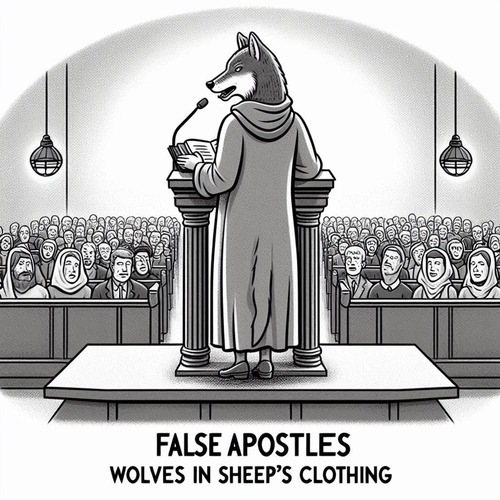Are Christianity’s Core Beliefs Borrowed from Mystery Religions?
**Editor’s Note: This post is part of our series, ‘Satan’s Lies: Common Deceptions in the Church Today’…
“Your faith is nothing special. Christianity just copied older pagan religions. Jesus is basically a rehashed version of dying-and-rising gods like Mithras, Osiris, and Dionysus.”
If we’ve spent any time online or in college classrooms, we’ve likely encountered this challenge. It’s become one of the most popular attacks on the Christian faith, spreading through social media, documentaries, and bestselling books.
So, are Christianity’s core beliefs borrowed? The short answer: No. The evidence overwhelmingly supports Christianity’s uniqueness and historical reliability. Let’s examine why this deception has gained traction and how believers can respond with confidence.
ARE CHRISTIANITY’S CORE BELIEFS BORROWED? WHERE DID THIS IDEA COME FROM?
This attack on Christianity didn’t emerge from ancient sources—it’s surprisingly modern. The “Christianity borrowed from paganism” theory originated in the late 1800s with German scholars known as the “History of Religions School.” These academics, influenced by evolutionary thinking, assumed that all religions naturally “evolved” by borrowing from earlier ones.
Scholars like Wilhelm Bousset and Richard Reitzenstein promoted these ideas, but their work was based on flawed methodology and selective evidence. Unfortunately, their theories lived on and found new life in popular culture through books like The Da Vinci Code, internet memes, and sensationalised documentaries.
Behind this academic confusion and cultural popularisation lies a deeper spiritual reality. Satan has always sought to undermine the uniqueness of Jesus Christ. If he can convince people Christianity is just another human invention, he can destroy faith in the Gospel’s power to save.
WHAT ARE THE ALLEGED PARALLELS?
Critics typically point to several supposed similarities between Christianity and ancient mystery religions:
- Virgin birth stories
- Gods who died and rose again
- December 25th birth dates
- Crucifixion-like deaths
- Saviour figures who died for humanity
The most commonly cited examples include Mithras (popular among Roman soldiers), Dionysus (Greek god of wine), Osiris (Egyptian deity), and others. At first glance, some parallels seem striking. But a closer examination reveals fundamental problems with these claims.
ARE CHRISTIANITY’S CORE BELIEFS BORROWED? THE HISTORICAL EVIDENCE
The Timing Problem
Here’s the most devastating fact for the “borrowing” theory: most of the detailed “parallels” between Christianity and pagan religions developed after Christianity was already established, not before.
When scholars examine the earliest sources for these mystery religions, the supposed similarities to Christianity are either absent or extremely vague. The more specific parallels appear in sources dating from the 2nd to 4th centuries AD—well after the Gospel accounts were written and widely circulated.
This creates an impossible timeline for Christian borrowing. You can’t borrow from sources that don’t exist yet.
Examining the “Parallels” Point by Point
Virgin Birth Claims: While some pagan stories describe gods mating with mortal women, these are not virgin births in any meaningful sense. They typically involve physical sexual encounters between gods and women. The biblical account of the virgin conception is utterly unique in ancient literature—a miraculous conception without any sexual activity.
Dying and Rising Gods: This is where the deception runs deepest. Ancient dying-and-rising god myths were seasonal stories about vegetation cycles. Gods like Osiris, Tammuz, and Adonis “died” and “returned” annually, representing the death and rebirth of crops.
Jesus’ death and resurrection is fundamentally different:
- It happened once in history, not cyclically
- It occurred at a specific time and place
- It was witnessed by multiple people who testified to it
- It accomplished eternal redemption, not seasonal renewal
Even sceptical scholars acknowledge these crucial differences. The late Jonathan Z Smith, a leading expert on ancient religions at the University of Chicago, wrote: “The dying and rising gods are not really parallel to Jesus.”
December 25th: Early Christians didn’t celebrate Jesus’ birth on December 25th. This date was chosen in the 4th century, likely to provide a Christian alternative to pagan winter festivals. The date of celebration has no bearing on the truth of the Incarnation itself.
The Jewish Context Changes Everything
Christianity emerged from a thoroughly Jewish context. The earliest Christians were Jews who maintained strict monotheism while proclaiming Jesus as Messiah. This environment was hostile to pagan mythological borrowing.
The disciples understood Jesus through Jewish categories: the promised Messiah, the suffering servant of Isaiah, the Passover lamb. Their proclamation that Jesus fulfilled specific Hebrew prophecies makes sense only within Jewish thought, not pagan mythology.
FUNDAMENTAL DIFFERENCES IN NATURE AND PURPOSE
Beyond timing issues, Christianity and the mystery religions differ in essential ways:
- Historical vs. Mythological: The Gospels present Jesus as a historical figure who lived in first-century Palestine under Roman rule. Mystery religions dealt with timeless mythical figures existing outside history.
- Moral vs. Amoral: Christianity demands moral transformation and holy living. Mystery religions typically involved ritual initiations without ethical requirements. The contrast between Jesus’ character and pagan deities is stark.
- Universal vs. Exclusive: The Gospel is offered freely to all people regardless of social status or wealth. Mystery religions were often expensive cults available only to those who could afford elaborate initiations.
WHY THEN DO SOME SIMILARITIES EXIST?
If Christianity didn’t borrow from paganism, why do any similarities exist at all?
- Common Human Longings: All cultures recognize humanity’s need for redemption, hope, and meaning. These universal longings, placed in human hearts by God, naturally appear in various religious expressions.
- Natural Revelation: Romans 1:19-20 teaches that God has revealed Himself to all people through creation and conscience. Some religious insights may reflect this general revelation.
- Spiritual Counterfeits: Satan’s strategy has always been to create counterfeits that confuse and discredit truth. Many pagan developments that occurred after Christianity’s emergence may represent demonic attempts to muddy the waters.
- Selective Reporting: Critics highlight vague similarities while ignoring fundamental differences, often reading modern interpretations back into ancient texts.
THE POSITIVE CASE FOR CHRISTIANITY’S UNIQUENESS
Rather than playing defence, Christians can make a positive case for their faith’s historical reliability:
- Early Sources: The New Testament documents are among the best-attested writings from the ancient world, with manuscripts dating much closer to their original composition than most classical texts.
- Enemy Attestation: Even hostile sources like Jewish and Roman writers acknowledged Jesus’ existence and the early Christian movement’s rapid growth.
- The Transformation Factor: Something dramatic happened to transform scared disciples into bold evangelists willing to die for their message. The resurrection best explains this historical puzzle.
- Archaeological Confirmation: Ongoing archaeological discoveries continue to confirm details mentioned in the Gospel accounts.
CONCLUSION: ARE CHRISTIANITY’S CORE BELIEFS BORROWED?
The attack claiming Christianity borrowed from mystery religions is ultimately an attack on the uniqueness of Jesus Christ. But historical investigation supports what believers have always proclaimed: Jesus isn’t just another religious figure in a long line of dying-and-rising gods. He is the unique Son of God who entered history to accomplish what no mythical deity ever could—the redemption of humanity.
This deception may shake some believers, but it need not shake us. The evidence is on our side. Christ’s uniqueness shines brighter when contrasted with the religions that tried to imitate Him after His resurrection changed the world.
ARE CHRISTIANITY’S CORE BELIEFS BORROWED? RELATED FAQs
Why did the Roman Empire eventually embrace Christianity over their traditional mystery religions? Roman mystery religions offered private spiritual experiences for the wealthy elite, while Christianity provided hope, community, and moral transformation for all social classes. The Gospel’s power to transform lives, combined with its historical grounding and eyewitness testimony, gave it credibility that mythical stories lacked. Emperor Constantine’s conversion reflected Christianity’s growing influence and demonstrated appeal across all levels of society.
- What about the argument that Paul, not Jesus, invented Christianity by borrowing from Greek mystery religions? This theory ignores Paul was a zealous Pharisee who would have been deeply opposed to pagan religious concepts. His letters show he was already proclaiming the same Gospel message the Jerusalem apostles preached, as confirmed in Galatians 2:1-10. Paul’s transformation from Christianity’s chief persecutor to its greatest missionary requires a dramatic explanation—his encounter with the risen Christ provides that explanation far better than gradual philosophical borrowing.
- How do we explain the fact that some Church Fathers like Justin Martyr acknowledged similarities between Christianity and paganism? Early Church Fathers like Justin Martyr (c. 100-165 AD) saw similarities as demonic counterfeits designed to discredit the true Gospel. Justin argued that demons, knowing God’s plan, created false religions to confuse people when the real Messiah arrived. Rather than evidence of borrowing, the Fathers viewed similarities as confirmation of spiritual warfare and Satan’s strategy to undermine truth with imitation.
Didn’t Christianity adopt pagan festivals and holy sites to make conversion easier? While the Church did later Christianise some pagan practices (particularly after Constantine), this occurred centuries after Christianity’s core beliefs were established. These accommodations involved external practices, not doctrinal content. The Incarnation, crucifixion, and resurrection were proclaimed from Christianity’s beginning, not added later to appeal to pagans. Cultural adaptation in non-essential matters differs completely from doctrinal borrowing.
- How can we be sure earlier versions of pagan myths didn’t influence Christianity, even if later versions were influenced by Christianity? Archaeological and textual evidence shows the detailed parallels critics cite simply don’t exist in pre-Christian sources. For example, pre-Christian Mithra texts contain no mention of virgin birth, crucifixion, or resurrection. When we examine the earliest available sources for these religions, the supposed parallels are either absent or extremely vague. The burden of proof lies on critics to produce pre-Christian sources containing specific parallels—which they cannot do.
- What about the claim that the Gospel of John was heavily influenced by Greek philosophy and mystery religions? While John’s Gospel uses Greek philosophical language (like “Logos”), this represents a translation and communication strategy, not theological borrowing. John was translating Hebrew concepts into Greek thought-forms to reach a Hellenistic audience, much like missionaries today adapt their message for different cultures. The content remains thoroughly Jewish and Christian—John explicitly states his purpose is to prove Jesus is the Jewish Messiah and Son of God (John 20:30-31).
If mystery religions were so different from Christianity, why were early Christians sometimes accused of practicing similar rituals? Roman critics like Pliny the Younger and Celsus attacked Christianity by comparing it to mystery cults precisely because they wanted to discredit it as “just another foreign superstition.” These were polemical attacks, not objective historical analysis. When we examine what early Christians actually practiced versus mystery cult rituals, fundamental differences emerge in meaning, purpose, and theological content. Critics used superficial similarities (like communal meals) to dismiss Christianity’s unique claims.
ARE CHRISTIANITY’S CORE BELIEFS BORROWED? OUR RELATED POSTS
Editor's Pick

Faithful to the Pattern: Why Paul Reserves Ordination for Men
Few topics in contemporary Christianity generate more tension than women’s ordination. This question touches real lives, genuine callings, and deeply [...]

‘Flee Sexual Sin’: Why Does Paul Single This Sin Out?
When the apostle Paul writes to the Corinthian church, he doesn’t tell them to simply avoid sexual immorality or resist [...]

Does Denying God’s Sovereignty Mean Denying the Gospel?
RC Sproul once warned denying God’s sovereignty “eviscerates” grace—a strong word meaning to gut or disembowel something, leaving only an [...]

Why Christians Fast: The Biblical Discipline’s Very Real Rewards
Why would Christians, who rejoice in the good gifts of food and fellowship, deliberately choose to go without? Isn’t fasting [...]

The Christian Sabbath: Why Did Sunday Replace Saturday?
Consider this: God-fearing Jews who’d faithfully observed Saturday Sabbath for over a thousand years suddenly began gathering for worship on [...]

Did the Early Christians Worship Jesus? The Biblical Evidence
It was a startling transformation: Jewish fishermen who'd spent three years following this itinerant carpenter from Nazareth now begin to [...]

If Jesus is Messiah, Why Aren’t ALL Messianic Prophecies Fulfilled?
If Jesus is truly the Messiah, why hasn't world peace arrived? Why do Jews still face persecution? Why isn't the [...]

When Courage Fails: Will I Be Forgiven If I Deny Christ in Persecution?
The rooster crowed, and Peter remembered. In that devastating moment, the apostle realised he’d just done the unthinkable—three times he’d [...]

What Makes a Godly Dad? 5 Biblical Principles Fathers Need
Modern culture sends fathers mixed messages. Be strong but sensitive. Be involved but not overbearing. Lead but don’t dominate. With [...]

What Makes a Godly Mom? A Scripture-Backed Guide
In our culture’s confusion about gender roles and parenting, the timeless question remains: what makes a godly mother? While secular [...]
SUPPORT US:
Feel the Holy Spirit's gentle nudge to partner with us?
Donate Online:
Account Name: TRUTHS TO DIE FOR FOUNDATION
Account Number: 10243565459
Bank IFSC: IDFB0043391
Bank Name: IDFC FIRST BANK






